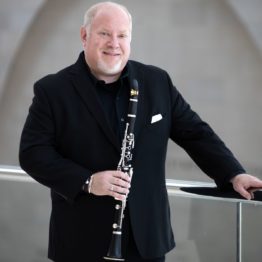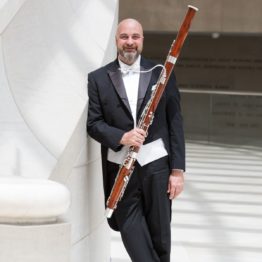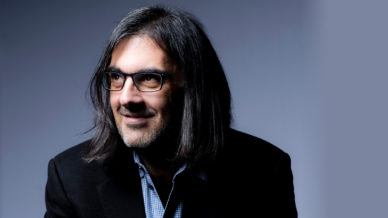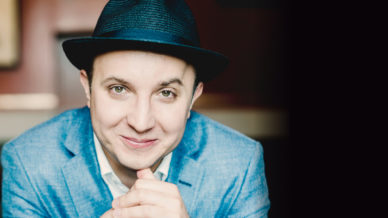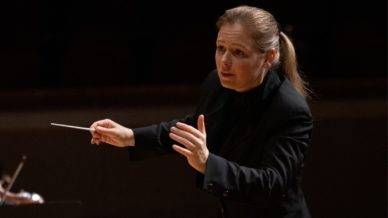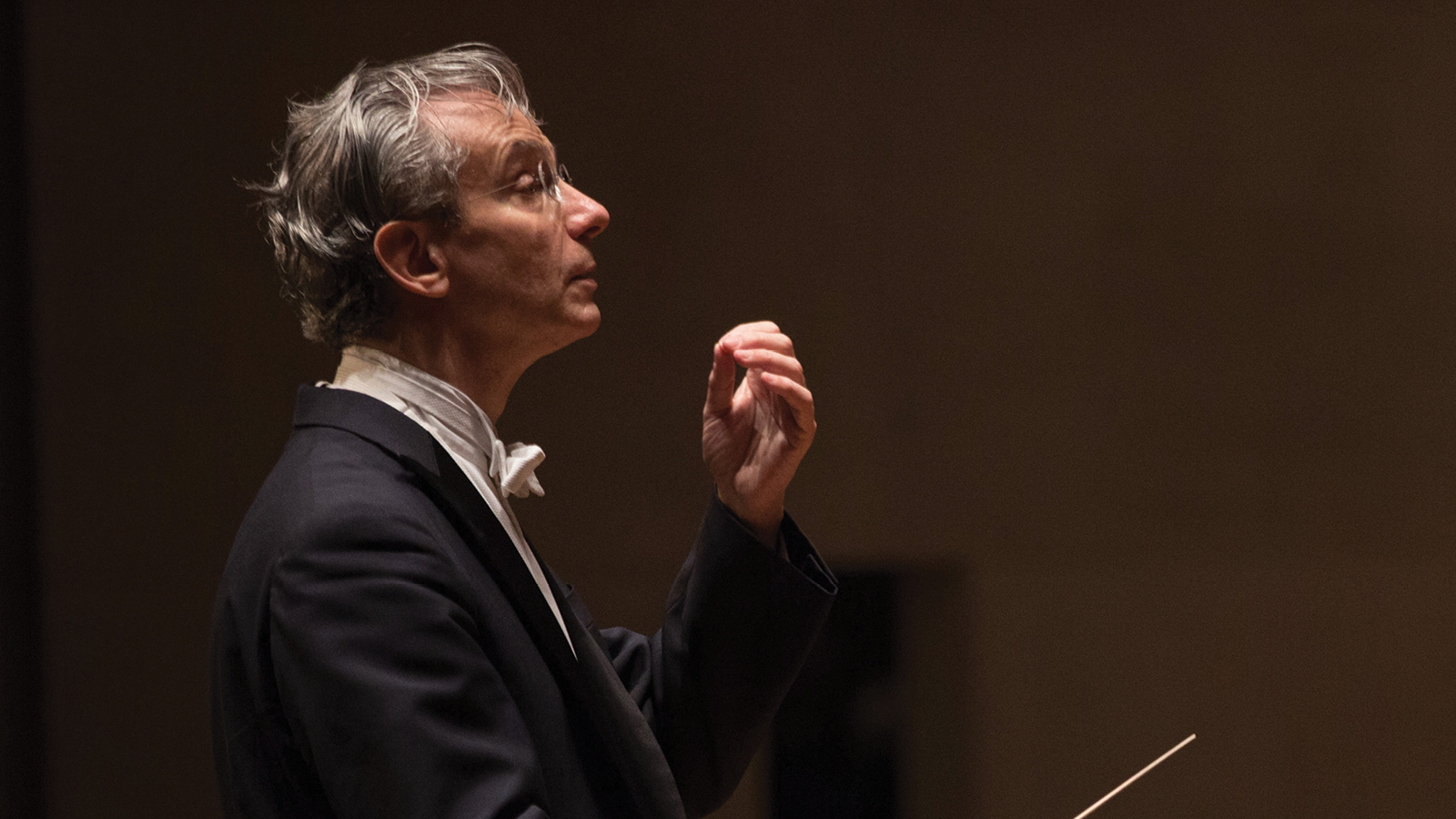

Berlioz Symphonie Fantastique
April 8 – 10, 2022
FABIO LUISI conducts
GREGORY RADEN clarinet
TED SOLURI bassoon
EINEM Capriccio
STRAUSS Duett-Concertino for Clarinet and Bassoon with String Orchestra and Harp
BERLIOZ Symphonie Fantastique
Berlioz describes his orchestral tour-de-force, penned when he was only 27, as a portrait of the life of an artist and his unrequited love, conjuring up hallucinatory visions of longing, obsession and the depth of despair all in glorious orchestral sounds.
For information on our COVID-19 safety protocols, please visit here.

Program Notes
by René Spencer Saller
This concert features three orchestral works completed at the very beginning and the very end of their composers’ respective careers. Two youthful compositions serve as bookends for a late-life masterpiece.
The Austrian composer Gottfried von Einem was 24 when he started writing his Capriccio for Orchestra, his earliest contribution to the repertoire. The Frenchman Hector Berlioz was a week shy of 27 when he unleashed Symphonie fantastique on an unsuspecting world, upending Classical proprieties in favor of something rich and strange.
The German composer Richard Strauss, for his part, was 83 when he completed his Duet-Concertino for Clarinet and Bassoon, and he wasn’t quite ready to step aside for the next generation—or even the one after that. In his final half-decade of life, the old man was creating some of the finest work of his career. This late-life renaissance produced such gems as the opera Capriccio (1942) and the Duet-Concertino, the last purely orchestral composition in his catalogue.
Strauss is connected to Berlioz in at least one important way: He edited and updated Berlioz’s essential Grand traité d’instrumentation et d’orchestration modernes, usually rendered in English as Treatise on Instrumentation. It’s fair to say that both Berlioz and Strauss literally wrote the book on modern orchestration.
Strauss and Einem were contemporaries and, at least from Einem’s perspective, mortal enemies. Einem called the octogenarian “an opportunist through and through” and, in his capacity as a member of the Salzburg Festival Board of Directors, even banned performances of Strauss’s works. The older composer was outraged by Einem’s baseless animosity, but the feud was cut short in 1949, when Strauss died.
Late in his own life, Einem acknowledged his own combative nature: “I was often quite unbearable, particularly also to my closest friends and partners. Today I regard this not from some lofty perch, not with detachment, but certainly with clarity.”
In December 2002, Yad Vashem, the Israeli Holocaust Memorial Organization, posthumously awarded the Swiss-born Austrian composer Gottfried von Einem a “Righteous Among the Nations” title, the greatest honor that the State of Israel can bestow on a gentile. More specifically, the members of Yad Vashem recognized his brave efforts on behalf of a young Jewish musician named Konrad Latte. Einem hired Latte as a rehearsal assistant for his ballet Princess Turandot; finagled him a ration book and membership in the Reich Musicians’ Chamber; and, perhaps most important, introduced him to other people who were willing to risk their lives to protect him.
Questioning authority came naturally to Einem. In 1950 he advocated for the playwright, poet, and librettist Bertolt Brecht, who was hoping to become a naturalized Austrian citizen. Einem agreed to help Brecht obtain an Austrian passport and commissioned a new piece for the Salzburg Festival. But faced with the fierce opposition of his political and cultural adversaries, who didn’t want a leftist agitator in their midst, Brecht elected to establish residency in East Germany instead. Because Einem had defended a Communist, he was accused of being one himself and labeled a “disgrace for Austria.” In late 1951 he was expelled from the Salzburg Festival Board.
Early Years
Throughout his childhood and adolescence, Einem believed himself to be the biological son of both his parents: his aristocratic mother, Gertha Louise, a scion of the House of Baron Riess von Scheuernschloss, and the man whose surname the family shared, the diplomat William von Einem, who was stationed in Switzerland as a military attaché to the Austrian embassy. At age 20 the composer learned that he was actually the product of an extramarital affair between his freewheeling mother and Count Laszlo Hunyady.
Growing up, Einem felt alienated from his family and social class. “I noticed that the world of sounds was endlessly important to me,” he recalled in his memoir. “By the age of five, I had already articulated my wish to be a composer with complete clarity.”
After graduating from high school in 1937, he continued to pursue his passion for music, cultivating a taste for Wagner and, more subversively, Mahler, whose works were banned by the Nazis. In a stroke of good luck, Einem was declared unfit for his mandatory military service after only two weeks of training. He moved to Berlin to study with Paul Hindemith, but the lessons fell through after Hindemith was targeted for investigation by Joseph Goebbels. Einem would find himself in precisely the same predicament a few years later.
Einem studied with other teachers, and in 1938 began assisting Heinz Tietjen at the Bayreuth Festival. Despite this powerful connection and his family’s close friendship with the Wagner heirs, Einem was arrested and briefly detained by the Gestapo.
A Closer Listen
Lasting between eight-and-a-half and nine minutes, Capriccio is a dynamic divertissement, a strong showpiece for any orchestra swift and responsive enough to follow its quicksilver logic. Exuberant percussion punctuates swoony strings, scampering winds, and voice-of-God brass. Bristling with tempo changes and sharp, syncopated rhythms, the compact orchestral workout demonstrates Einem’s mastery of counterpoint, which he studied extensively with Boris Blacher, his composition teacher, friend, fellow jazz fan, and future librettist.
Strauss, a devoted aesthete, always claimed to be apolitical, but that didn’t stop him from working for the Third Reich. From 1933 to 1935, he served as director of the Reichsmusikkammer. The position—for which he was, to his credit, monumentally unsuited—called for a kind of bureaucratic enforcer, a culture cop purging German music of all non-Aryan elements. He lost the job when he was caught bad-mouthing his Nazi handlers in a letter to his Jewish librettist, a gaffe that no amount of abject backpedaling and groveling could undo.
Like most people, Strauss was neither a monster nor a saint. Unlike Einem, he didn’t act heroically to combat injustice, but he did love his family, and he did try his best to protect those he loved. He was, in the immortal phrase of a favorite philosopher, Human, All Too Human.
He had spent the war years worrying about his Jewish daughter-in-law and grandchildren. Although he was devastated when Allied forces obliterated his beloved opera houses—a real-life Twilight of the Gods scenario—Strauss had long detested the ignorant barbarism of the Third Reich, and above all he craved peace, tolerance, and safety. Even in his grief he clung to his hope for humanity. This scrappy optimism pervades Metamorphosen (1945), his iconic elegy for string orchestra.
Many listeners have claimed to hear a similar spirit of reconciliation in the Duet-Concertino, wherein two seemingly incompatible lead instruments find common ground. Strauss’s immediate reason for writing the double concerto was to fulfill a commission that he had received from Otmar Nussio for the Orchestra della Svizzera Italiana. Strauss also wanted to pay tribute to an old friend, Professor Hugo Burghauser, the former principal bassoonist for the Vienna Philharmonic and the work’s dedicatee.
From Intention to the Airwaves
In 1946 Strauss first wrote Burghauser about his idea: “I am very busy with an idea for a double concerto for clarinet and bassoon, thinking especially of your beautiful tone—nevertheless, apart from a few sketched-out themes, it still remains no more than an intention.”
About a year later, the intention was fully realized. He finished the Duet-Concertino while living in Switzerland, where he had moved after the war to avoid testifying in the denazification proceedings. This was a period of severe financial hardship for the composer because his assets were frozen until his own legal status was resolved. He was cleared in 1948, the same year that the Duet-Concertino debuted. The world premiere was broadcast on Radio Lugano on April 4, 1948, under Nussio’s baton. Strauss didn’t attend the live performance, but he may have tuned in to the radio broadcast. In 1949 he returned to Germany, where he would die within the year.
Although Strauss didn’t include a written program for the Duet-Concertino, he did have a specific story in mind—or, more accurately, a few similar stories. He told Burghauser that he based the double concerto on the French fairy tale Beauty and the Beast. He also told the bassoonist that he imagined a scene in which a graceful princess meets a clumsy bear, whose “grotesque cavorting” alarms her at first but eventually wins her over. Strauss told the conductor Clemens Krauss that the Duet-Concertino was inspired by the Hans Christian Andersen tale “The Swineherd,” wherein a prince disguises himself as a humble pig-tender to earn the love of a princess. Regardless of the chosen narrative, the clarinet always plays the princess and the bassoon always plays the lowly suitor.
A Closer Listen
The Duet-Concertino is scored in the style of the Baroque-era concerto grosso. Although Strauss used the standard orchestral setup of strings and harp, he divided the string section into five parts, consisting of performers designated soli (soloists, or the lead players for each of the five sections) and tutti (all other members of each section). The opening bars showcase each of the five soloists, joined by a second viola.
The Duet-Concertino is structured in three movements: Allegro moderato, Andante, and a rondo marked Allegro ma non troppo. The outer movements are more substantial, with the central Andante functioning more as a transitional intermezzo than a traditional slow movement. The supple, long-breathed clarinet dominates the lyrical, quasi-Mozartian opening section, which introduces the princess. Strauss suggests the clumsiness of her improbable beau by using a different time signature for the solo bassoon. Try as he might, the bear (or beast, or swineherd, depending on your preferred origin story) can’t seem to match step with his beloved. The Andante begins with a tender bassoon soliloquy, in which the aspiring lover reveals his inner nobility and manages to win the princess’s heart. After the clarinet and bassoon exchange motifs, they weave all the various themes into a spirited, dance-based rondo, the last and longest of the three movements.
With Berlioz, there was always a new passion: a new woman to stalk, a new polemic to publish, a new musical project to launch. His obsession with Harriet Smithson was all that to the infinite power. On September 11, 1827, the Irish-born actress played Ophelia in a performance of Hamlet that the composer attended. The double-whammy of Smithson and Shakespeare hit him hard, in what the French call a coup de foudre, and everything changed forever.
His love for Shakespeare was chronic and benign. His love for Smithson raged on for several years—never mind that he spoke very little English, she barely any French; never mind that he was, at least at the beginning of the affair, engaged to marry another woman (a woman whom he later plotted to murder, along with her mother and fiancé, but that’s another story). After enduring the sort of courtship that would instigate a restraining order today, Smithson married Berlioz. Ruin and sorrow ensued.
Although Berlioz didn’t invent musical Romanticism, no one was a better figurehead for its wild early days. His scandalous personal life, his groundbreaking sonic experiments, and his inflammatory music reviews changed the course of 19th-century culture. His Symphonie fantastique stands as one of the most influential symphonic works in music history.
Long Strange Trip
In 1969, during one of his Young People’s Concerts, the conductor Leonard Bernstein called Symphonie Fantastique “the first psychedelic symphony in history.” Summarizing its story line, he quipped, “Berlioz tells it like it is. You take a trip, you wind up screaming at your own funeral.”
Hippie jive aside, Bernstein was essentially paraphrasing the composer’s own program notes, which Berlioz maintained were indispensable for a complete understanding of his work. Earlier symphonies—such as Beethoven’s Sixth Symphony (Pastorale), a major influence on Symphonie Fantastique—depicted landscapes and moods, but none told a story so explicitly, with particular melodies and sound effects lining up with specific characters and plot points. Symphonie fantastique is an opera without singers.
Today we recognize Berlioz’s symphonic debut as the archetypal program symphony—music that describes characters, events, and emotions, as opposed to absolute music, which is, at least theoretically, nonrepresentational—but audience members at the 1830 Paris premiere were unprepared for such detailed notes, especially on such a sordid topic.
Here’s the synopsis: A sensitive young artist (obviously Berlioz) falls desperately in love with a total stranger (obviously Harriet Smithson); attempts to poison himself with opium; but instead has a nightmare about murdering his beloved, being condemned to death by guillotine, witnessing his own execution, and attending his own funeral in the company of ghouls, witches, and devils.
Shock value aside, Symphonie fantastique is a singular achievement. It embodied a new art form, a synthesis of music, literature, drama, and autobiography. Richard Wagner, 10 years younger than Berlioz, tweaked this concept, called it the Gesamtkunstwerk (“total work of art”), and made it his life’s mission. Berlioz’s oft-mentioned idée fixe—the recurrent melody that serves as his Smithson proxy and unifies the symphony’s five movements—predated the Wagnerian leitmotif, too. His daring harmonies and strange instrumental sonorities (the final movement’s col legno bowing, which sounds like rattling skeletons, for example) anticipated similar sound experiments by 20th-century avant-gardistes.
A Closer Listen
The first movement, a bipolar fantasy, subverts sonata form. The second movement, a decorous waltz, contrasts a ballroom party (two harps: swanky!) with the hero’s interior torment; before long, the objective and subjective realms collide in dazzling polyphony. In the third movement a pastoral call-and-response duet between two shepherds (listen for the off-stage oboe and on-stage English horn) dramatizes the artist’s isolation and despair. In the fourth movement, the artist takes the opium that triggers his horrific nightmare.
In his program notes Berlioz wrote, “The procession moves forward to the sounds of a march now somber and ferocious, now brilliant and stately…. At the end of the march, the first four measures of the idée fixe reappear like a last thought of love interrupted by the fatal blow.”
In other words, he remembers the woman he killed, and kerplunk! goes his head. When the beloved’s theme, once “noble and shy,” returns in the finale, it has devolved into a vulgar jig voiced by a shrill clarinet. Before the movement ends, witches enact a burlesque parody of the medieval plainchant Dies irae from the Requiem mass. With that bold move, Berlioz kick-starts Romanticism and accidentally invents black metal.

